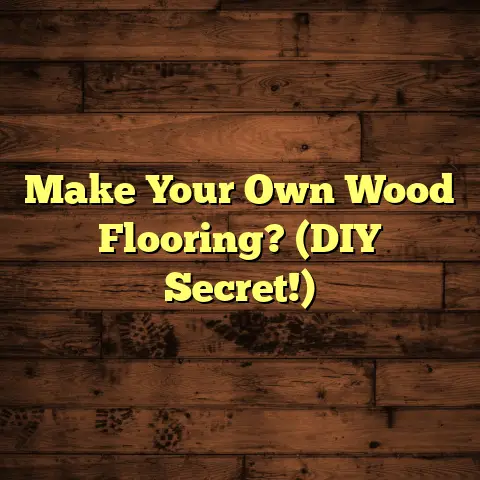Fix Squeaky Floors Under Carpet? (1-Day Fix!)
Is your home supposed to be a sanctuary, a place to unwind after a long day?
But instead, every step you take is announced by an orchestra of annoying squeaks?
I get it. As a flooring contractor for over 15 years, I’ve seen firsthand how disruptive squeaky floors can be.
It’s not just an annoyance; it can genuinely impact your quality of life. Think about it: trying to relax, watching a movie, or even putting the baby to sleep. Squeak, squeak, squeak! It’s enough to drive anyone crazy.
And let’s be honest, it’s not exactly the impression you want to give guests, right?
That’s why I’ve put together this guide. I’m going to walk you through a practical, one-day solution to silence those squeaky floors under your carpet.
No more embarrassment, no more frustration, just peace and quiet. Let’s get started!
1. Understanding Squeaky Floors
1.1 Causes of Squeaky Floors
What makes a floor suddenly decide to start singing (or rather, squeaking) every time you walk across it?
There’s usually a culprit, or a combination of them. Here’s what I’ve seen most often:
-
Loose Floorboards: This is probably the most common reason. Over time, the nails or screws holding your floorboards down can loosen, creating movement.
-
Friction: When those loose boards rub against each other, or against the subfloor, you get that telltale squeak. It’s like two pieces of sandpaper grinding together.
-
Humidity & Temperature Changes: Wood expands and contracts with changes in humidity and temperature. This can cause boards to shift and loosen. I’ve seen seasonal squeaks that appear in the winter and disappear in the summer.
-
Wear and Tear: Let’s face it, floors take a beating. Years of foot traffic, furniture moving, and general wear and tear can all contribute to squeaks.
The type of flooring and how it was installed also play a role. For example, hardwood floors are more prone to squeaking than some types of vinyl, especially if they weren’t properly nailed or glued down during installation.
1.2 The Impact of Squeaky Floors
on Daily Life
Okay, so squeaky floors are annoying. But is it really that big of a deal?
Honestly, yes. I’ve had clients tell me that their squeaky floors were a constant source of stress and anxiety.
Imagine trying to work from home with a symphony of squeaks under your feet. Concentration? Forget about it!
Or picture this: you’re finally relaxing after a long day, sinking into your couch with a good book. But every time someone walks past, squeak! Your relaxation bubble is burst.
I even had one client who said she was embarrassed to have guests over because of the noise. It made her feel like her house was falling apart, even though it was perfectly structurally sound.
According to a study by the National Association of Realtors, noise reduction is a key factor in homebuyer satisfaction. While the study doesn’t specifically address squeaky floors, it highlights the importance of a quiet and peaceful home environment.
In short, squeaky floors can impact your mood, your productivity, and your overall sense of well-being.
2. Preparing for the Fix
2.1 Assessing the Problem
Before you start tearing up your carpet, it’s important to figure out exactly where the squeaks are coming from.
This might sound obvious, but trust me, it’s easy to misjudge the source of a noise.
Here’s my method:
-
The Walk-Around: Slowly walk around the room, paying close attention to where the squeaks occur. Try to pinpoint the exact location.
-
The Helper Method: Enlist a friend or family member. Have them walk on the floor while you listen carefully from below (if you have access to a basement or crawl space) or from different angles in the room.
-
The Pressure Test: Once you think you’ve found the spot, apply pressure with your foot. Does it squeak under pressure? Does it only squeak when you step in a certain direction?
-
Mark the Spots: Use painter’s tape to mark the exact locations of the squeaks. This will save you time and frustration later.
2.2 Gathering Tools and Materials
Alright, so you’ve identified the squeaky culprits. Now it’s time to gather your arsenal of tools and materials.
Here’s what I recommend having on hand:
-
Utility Knife: For cutting the carpet and padding. A sharp blade is essential for clean cuts.
-
Squeak No More Kit or Powdered Graphite: The “Squeak No More” kit is designed specifically for fixing squeaky floors. Powdered graphite can be used to lubricate the floorboards and reduce friction.
-
Wood Screws or Nails: Depending on the situation, you might need to add extra screws or nails to secure the floorboards. I usually recommend screws, as they tend to hold better over time.
-
Drill: For pre-drilling pilot holes and driving in screws.
-
Measuring Tape: For measuring the floorboards and carpet.
-
Carpet Knife: For cutting and trimming the carpet.
-
Safety Gloves and Goggles: Safety first! Protect your hands and eyes from dust, splinters, and sharp objects.
You can find most of these items at your local hardware store or online retailers like Amazon or Home Depot.
Pro Tip: Don’t skimp on quality when it comes to tools. A good drill and sharp utility knife will make the job much easier and safer.
3. The Fixing Process
3.1 Preparing the Area
Before you start wielding your utility knife and drill, it’s important to prepare the area.
This means:
-
Clearing the Furniture: Move all furniture out of the way. This will give you plenty of room to work and prevent damage to your belongings.
-
Removing Obstacles: Take down any wall hangings or decorations that might be in the way.
-
Protecting the Surroundings: Cover any nearby surfaces with drop cloths or plastic sheeting to protect them from dust and debris.
-
Ventilation: Open windows or turn on a fan to improve ventilation. This is especially important if you’re using any solvents or lubricants.
3.2 Lifting the Carpet
This is where things get a little tricky. You need to lift the carpet without damaging it or the surrounding areas.
Here’s my step-by-step guide:
-
Locate the Seam: Most carpets are installed in sections, with seams running along the edges of the room. Find the seam closest to the squeaky area.
-
Use the Utility Knife: Carefully cut along the seam with your utility knife. Use a straight edge as a guide to ensure a clean, straight cut. Don’t cut all the way through the carpet at once. Score it first, then go back and deepen the cut.
-
Roll Back the Carpet: Once you’ve cut the seam, gently roll back the carpet to expose the floor underneath. Be careful not to tear the carpet or damage the tack strips along the edges of the room.
-
Inspect the Padding: Check the carpet padding for any signs of damage or wear. If the padding is old or worn, consider replacing it.
Important: If you’re not comfortable cutting the carpet yourself, you can hire a professional carpet installer to do it for you.
3.3 Identifying Problematic Floorboards
Now that the carpet is out of the way, you can get a good look at the floorboards.
Here’s what to look for:
-
Gaps: Check for gaps between the floorboards. These gaps can allow the boards to move and rub against each other, causing squeaks.
-
Movement: Step on each floorboard and see if it moves or flexes. If it does, it’s likely loose.
-
Loose Nails or Screws: Look for any nails or screws that are sticking up or are not fully embedded in the wood.
-
Stains or Water Damage: Check for any signs of water damage, such as stains, mold, or rot. Water damage can weaken the floorboards and make them more prone to squeaking.
3.4 Securing Loose Floorboards
Once you’ve identified the loose floorboards, it’s time to secure them.
Here’s how:
-
Pre-Drill Pilot Holes: Use a drill to pre-drill pilot holes through the floorboard and into the joist below. This will prevent the wood from splitting.
-
Choose the Right Screws: Use wood screws that are long enough to penetrate the joist by at least 1 inch. I usually recommend using screws that are 2-2.5 inches long.
-
Drive in the Screws: Drive the screws into the pilot holes until they are flush with the surface of the floorboard. Don’t over-tighten the screws, as this can strip the wood.
-
Apply Lubricant: If the floorboards are still squeaking after you’ve secured them, you can try applying powdered graphite or another lubricant between the boards. This will help reduce friction and eliminate the squeak.
Alternative: Squeak No More Kit: If you want a more specialized solution, consider using a “Squeak No More” kit. These kits come with special screws and a tool that allows you to drive the screws in at an angle, making them less visible.
3.5 Replacing Damaged Boards (if necessary)
In some cases, the floorboards might be too damaged to repair. If they’re cracked, rotted, or severely warped, you’ll need to replace them.
Here’s how:
-
Measure and Cut: Measure the length and width of the damaged floorboard. Then, use a saw to cut a new floorboard to the same size.
-
Remove the Old Board: Use a pry bar to carefully remove the old floorboard. Be careful not to damage the surrounding boards.
-
Install the New Board: Place the new floorboard in the opening. Make sure it fits snugly and is flush with the surrounding boards.
-
Secure the New Board: Use nails or screws to secure the new floorboard to the joists below.
Important: When replacing floorboards, make sure to use the same type of wood as the existing floor. This will ensure a consistent look and prevent the new board from expanding or contracting at a different rate than the old boards.
4. Reinstalling the Carpet
4.1 Preparing the Carpet for Reinstallation
Before you roll the carpet back into place, it’s a good idea to give it a good cleaning.
Here’s what I recommend:
-
Vacuum Thoroughly: Vacuum the carpet on both sides to remove any dust, dirt, or debris.
-
Spot Clean Stains: Use a carpet cleaner to spot clean any stains or spills.
-
Check for Damage: Inspect the carpet for any signs of damage, such as tears, holes, or worn spots. If you find any damage, repair it before reinstalling the carpet.
4.2 Reinstalling the Carpet
Now comes the moment of truth: reinstalling the carpet.
Here’s my step-by-step guide:
-
Align the Carpet: Carefully align the carpet with the edges of the room. Make sure the seams line up properly.
-
Stretch the Carpet: Use a carpet stretcher to stretch the carpet tight. This will help prevent wrinkles and buckling.
-
Secure the Edges: Use a carpet tucker to tuck the edges of the carpet under the baseboards.
-
Reattach the Seams: Use carpet tape or seam sealer to reattach the seams. This will prevent the seams from separating over time.
4.3 Finishing Touches
Once the carpet is reinstalled, there are a few finishing touches you can add to make sure everything looks perfect.
Here’s what I recommend:
-
Replace Furniture: Put the furniture back in its original position.
-
Trim Excess Carpet: Use a carpet knife to trim any excess carpet along the edges of the room.
-
Vacuum Again: Vacuum the carpet one last time to remove any loose fibers or debris.
-
Test for Squeaks: Walk around the room and listen for any remaining squeaks. If you still hear squeaks, repeat the fixing process until they’re gone.
Conclusion
So, there you have it! A comprehensive guide to fixing squeaky floors under carpet in just one day.
By following these steps, you can silence those annoying squeaks and enjoy a quieter, more peaceful home environment.
Remember, a little bit of effort can go a long way in improving your quality of life. Don’t let squeaky floors drive you crazy any longer. Take action today and reclaim your peace and quiet!





